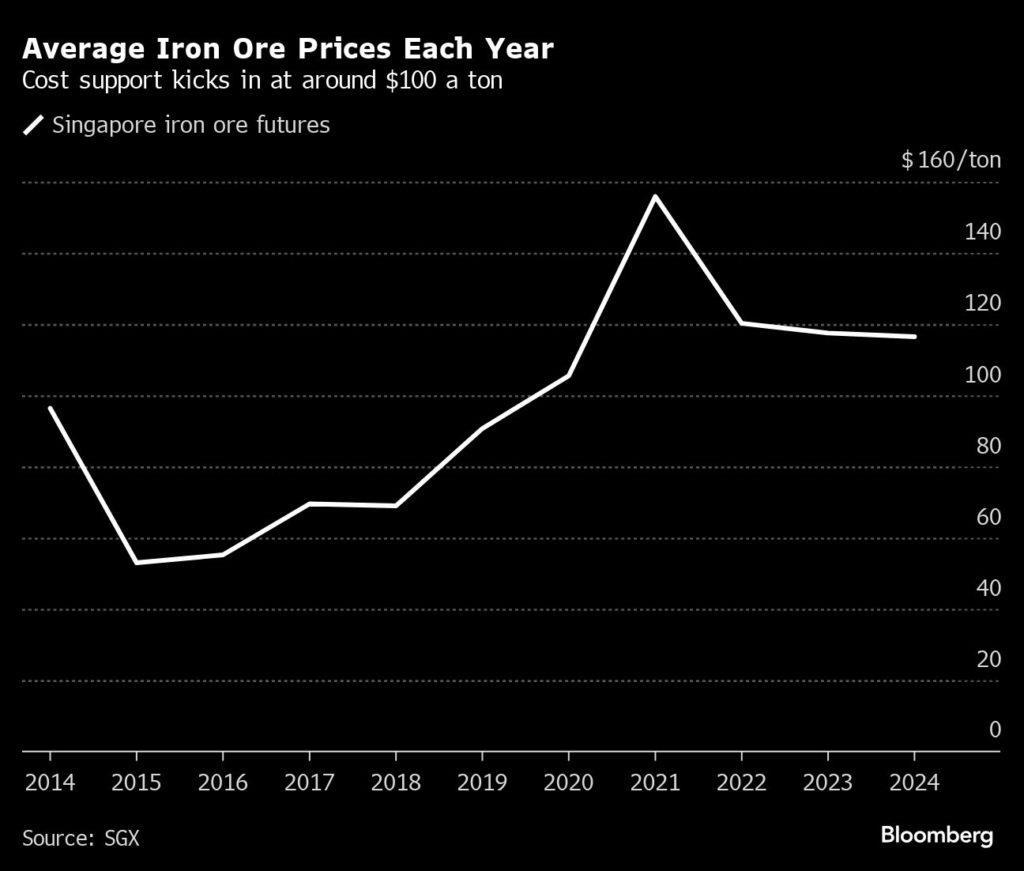The bottom price of iron ore at $100 is in danger of collapse due to a rapid increase in supply
Iron ore prices are fairly isolated from the Chinese economic downturn due to cost support activated at around $100 per ton, so there is a high possibility that it will stay in the 3-digit range for the rest of 2024.
However, there is a possibility that the situation will change from next year as a wave of cheap supply surges into West Africa, the average cost of the iron ore industry falls, and prices are forced to better reflect the long-term decline of the steel industry in China, which is the largest consumer of iron ore.
The world's largest undeveloped ore reserves in Simandou, Guinea are strengthening production preparations. According to the Macquarie Group, the project will supply 5 million tons from 2025, and there is a possibility that it will steadily expand to 90 million tons per year in 2028.
Liz Gao, a senior analyst at the consultancy company CRU Group, said, “The nominal production capacity is 0.1 billion 20 million tons. By that time, she says, “the balance of the market will be adjusted, and there will be room for high-cost producers to withdraw from the market and accept new production volumes from Simandou.”

Mining iron ore, the main raw material for steel, is a great business for the world's leading mining companies. Due to China's rapid growth and laser-like concentration on lowering costs, producers such as Rio Tinto and the BHP Group have made huge profits year after year. However, the decline in demand in China overlapped with the increase in supply, and there is a risk that the outlook for iron ore, which is currently the pillar of earnings, will collapse.
As consumption in China is slowing down, iron ore futures, which are the benchmark, have fallen 23% this year to around $109 per ton. Twice in recent months, the Singapore deadline has broken through $100, but if prices fall below this level, there was an immediate rebound from the threat that high-cost mining companies around the world would be forced to curb production. However, it seems that such cost support will become increasingly fragile in the future.
The situation in China is unfavorable to the long-term demand outlook for iron ore. The Chinese economy is not growing as rapidly as it once was, and steel intensity is declining as it matures. The real estate sector, which is the biggest source of demand, is in the midst of a protracted crisis. The government is trying to set an upper limit on steel production at or below the same level as the previous year in order to reduce excess production capacity and reduce emissions. The industry is also recycling existing steel and proceeding with the expansion of electric furnaces with low carbon intensity.
large mass
Simandu supplies the majority of the 1.6 billion tons of iron ore sold each year on the global market. Australian mining companies now account for more than half of that. Rio Tinto, BHP, and Fortescue Limited, which are the world's largest suppliers, also control the lower end of the cost curve and produce ore at $18 to $24 per ton. Brazil's Vale SA, the world's second-largest iron ore digger, produces at $21 per ton.
This means huge profits for major companies despite falling prices. However, the cost of Simandu, which is divided into northern and southern blocks, would be comparable to the cheapest supply currently available. According to Vivek Dahl, an analyst at Commonwealth Bank of Australia, the long-term price of iron ore is only $68 per ton.
Also, there are other supply issues. The Guinean project, where not only Chinese investors but also Rio is listed as a developer, is part of China's effort to raise the self-sufficiency rate for high-grade iron ore to 45% by 2025. According to Bloomberg Intelligence, in order to achieve this from 17% in 2023, it is necessary to at least double supply by next year, and this is likely to put pressure on prices to rise.
Port inventory
Simandou is not the only large-scale mine that is expanding operations. Mineral Resources' project in Onslow, Australia, is expected to achieve an annual production capacity of 35 million tons by 2025/6. The project shipped the first iron ore to China Baowu Steel Group in May ahead of schedule.
Even if Simandu ore does not appear on the market, high-cost mines are being closed. Minerals Resources has announced that it will close the Iilgaon project in Western Australia from early next year due to cost reasons.
Even as the increase in overseas production gains momentum, Chinese buyers have already received sufficient supply this year. Port inventories have expanded to their highest level in the past 2 years.
As the economic slowdown continues to drag prices, investors' interest is focused on whether Beijing will provide further policy support to revitalize the housing market, says product strategist Soni Kumari at ANZ Group Holdings. However, even if economic stimulus measures are launched again at the 3rd NPC next week, it is still unclear to what extent they will concentrate on commodities.
Attila Widnell, managing director of Singapore's Navigate Commodities Pte.Ltd., said, “The current situation is reminiscent of market dynamics 10 years ago, when prices fell below $40 per ton, driven by China's “terrible” domestic demand and abundant supply.
“I'm just praying that history doesn't repeat itself.
Disclaimer: Community is offered by Moomoo Technologies Inc. and is for educational purposes only.
Read more
Comment
Sign in to post a comment
